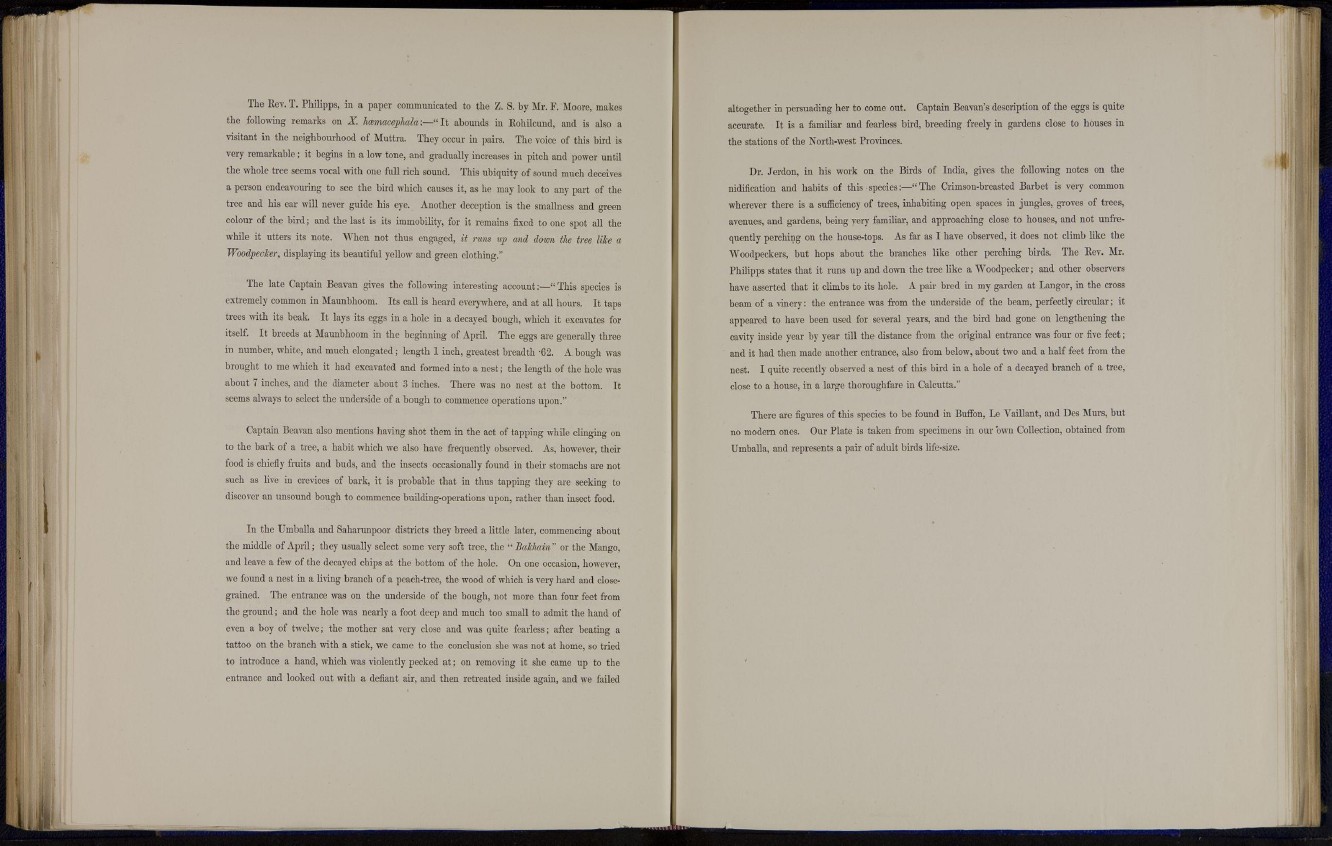
The Rev. T. Philipps, in a paper communicated to the Z. S. by Mr. F. Moore, makes
the following remarks on X. hwmacephala:—" It abounds in Rohilcund, and is also a
visitant in the neighbourhood of Muttra. They occur in pairs. The voice of this bird is
very remarkable; it begins in a low tone, and gradually increases in pitch and power until
the whole tree seems vocal with one full rich sound. This ubiquity of sound much deceives
a person endeavouring to see the bird which causes it, as he may look to any part of the
tree and his ear will never guide his eye. Another deception is the smallness and green
colour of the bird; and the last is its immobility, for it remains fixed to one spot all the
while it utters its note. When not thus engaged, it runs up and down the tree like a
Woodpecker, displaying its beautiful yellow and green clothing."
The late Captain Beavan gives the following interesting account:—"This species is
extremely common in Maunbhoom. Its call is heard everywhere, and at all hours. It taps
trees with its beak. It lays its eggs in a hole in a decayed bough, which it excavates for
itself. It breeds at Maunbhoom in the beginning of April. The eggs are generally three
in number, white, and much elongated; length 1 inch, greatest breadth "62. A bough was
brought to me which it had excavated and formed into a nest; the length of the hole was
about 7 inches, and the diameter about 3 inches. There was no nest at the bottom. It
seems always to select the underside of a bough to commence operations upon."
Captain Beavan also mentions having shot them in the act of tapping while clinging on
to the bark of a tree, a habit which we also have frequently observed. As, however, their
food is chiefly fruits and buds, and the insects occasionally found in their stomachs are not
such as live in crevices of bark, it is probable that in thus tapping they are seeking to
discover an unsound bough to commence building-operations upon, rather than insect food.
In the Umballa and Saharunpoor districts they breed a little later, commencing about
the middle of April; they usually select some very soft tree, the " Bakhain " or the Mango,
and leave a few of the decayed chips at the bottom of the hole. On one occasion, however,
we found a nest in a living branch of a peach-tree, the wood of which is very hard and closegrained.
The entrance was on the underside of the bough, not more than four feet from
the ground; and the hole was nearly a foot deep and much too small to admit the hand of
even a boy of twelve; the mother sat very close and was quite fearless; after beating a
tattoo on the branch with a stick, we came to the conclusion she was not at home, so tried
t o introduce a hand, which was violently pecked a t ; on removing it she came up to the
entrance and looked out with a defiant air, and then retreated inside again, and we failed
altogether in persuading her to come out. Captain Beavan's description of the eggs is quite
accurate. It is a familiar and fearless bird, breeding freely in gardens close to houses in
the stations of the North-west Provinces.
Dr. Jerdon, in his work on the Birds of India, gives the following notes on the
nidification and habits of this species:—" The Crimson-breasted Barbet is very common
wherever there is a sufficiency of trees, inhabiting open spaces in jungles, groves of trees,
avenues, and gardens, being very familiar, and approaching close to houses, and not unfrequently
perching on the house-tops. As far as I have observed, it docs not climb like the
Woodpeckers, but hops about the branches like other perching birds. The Rev. Mr.
Philipps states that it runs up and down the tree like a Woodpecker; and other observers
have asserted that it climbs to its hole. A pair bred in my garden at Langor, in the cross
beam of a vinery: the entrance was from the underside of the beam, perfectly circular; it
appeared to have been used for several years, and the bird had gone on lengthening the
cavity inside year by year till the distance from the original entrance was four or five feet;
and i t had then made another entrance, also from below, about two and a half feet from the
nest. I quite recently observed a nest of this bird in a hole of a decayed branch of a tree,
close to a house, in a large thoroughfare in Calcutta."
There are figures of this species to be found in Buffon, Le Vaillant, and Des Murs, but
no modem ones. Our Plate is taken from specimens in our own Collection, obtained from
Umballa, and represents a pair of adult birds life-size.